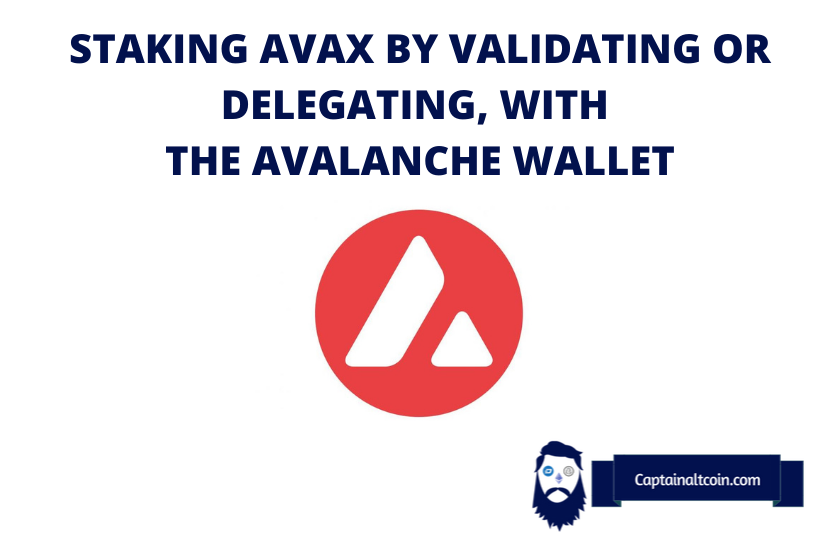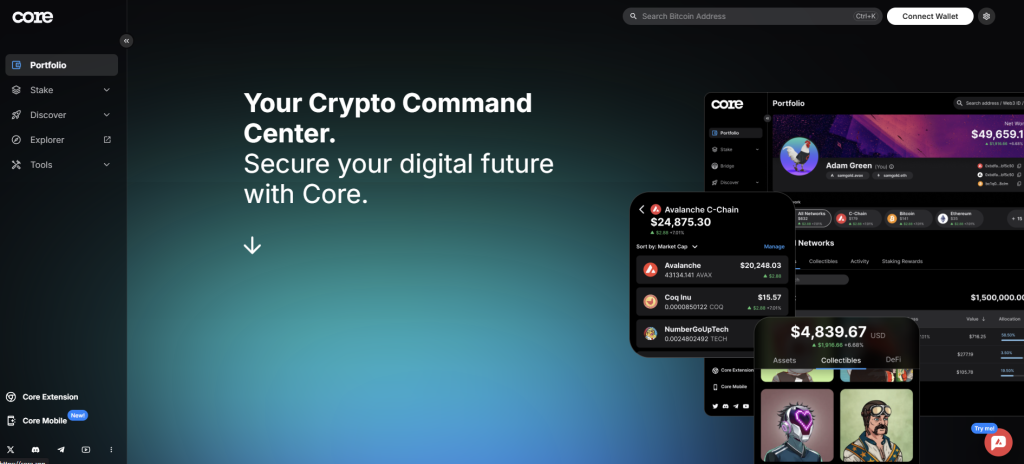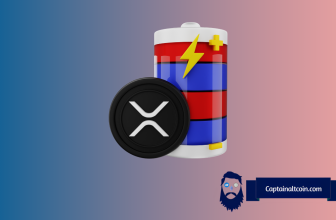
Avalanche is a smart contracts platform that helps you deploy and build dApps at a low cost. It focuses on scalability, decentralization, security, and flexibility. Avalanche is one of open-source platforms for global finance’s scalability and fast transaction speed through its proof of Stake (POS) consensus protocol. It uses AVAX as its native cryptocurrency.
There exist two ways users can stake AVAX, by becoming a delegator or by becoming a validator. But before we go in-depth into what delegation and validation mean, let’s briefly consider what staking is.
What you'll learn 👉
AN INTRODUCTION TO STAKING
Simply put, staking is storing or locking crypto assets in an account for some time in return for a reward. This process supports the functionality and aids the security of a blockchain. It allows users to join the blockchain community and take part in the administration and unison of the blockchain.
Under the POS system, when users stake their coins, they give them to the crypto protocol to add new blocks to the blockchain, which validators will confirm. The staker earns additional coins plus the initial amount of staked coins.
Instead of leaving your cryptos sleeping in your wallet, why not give thought to utilizing them in this way to earn passive income.
Note: If you’ve staked AVAX before, you might remember using the “Avalanche Wallet.” That’s now been replaced by AVAX Core Stake, Avalanche’s official staking interface. It comes with a more modern UI, smoother cross-chain transfers, better validator discovery tools, and real-time reward tracking. Whether you’re a delegator or validator, Core Stake makes managing your staking experience much easier.
VALIDATOR
A validator is a node operator that plays the role of verifying transactions on the blockchain. On Avalanche, validators must meet the requirements to stake a certain amount of AVAX token and properly participate in the network to secure their rights as validators and receive rewards.
Your chance of being awarded as a validator rests on the number of coins you stake. The more your stake remains locked, the higher the reward you earn. If you, as a validator, stakes for up to a year, you receive the maximum rate of rewards and the lowest rate of rewards for staking up to 14 days.
Before transactions are taken to the blockchain ledger, a validator checks their legitimacy and accuracy whether or not it conforms to the blockchain’s rule. Validators may have to consider the transaction fee sent by the initiator of each transaction before deciding which to create as a block.
DELEGATOR
A delegator is a token holder who earns rewards but does not directly participate in the consensus process. A delegator chooses a current validating node to delegate his AVAX to.
As a delegator, you must indicate:
- The node ID you want to delegate
- The number of AVAX you choose to stake
- The Start time and End time must not exceed the validator’s own time
- The wallet address your rewards will be sent to
It is paramount to know that you cannot affect the parameters once you have added your stake to a delegator. Your reward comes after your delegation, provided your validator remains correct and online. Do not forget that validators have rights to a slice of the reward you receive.
STAKING PARAMETERS
- The least amount a delegator should stake is 25 AVAX, while that of a validator is 2000 AVAX
- The least period coins can be staked for validation is 2 weeks, while the maximum duration is 1 year
- The lowest delegation fee is 2%
- Since validators’ rewards are centered on Proof of Uptime and Correctness, the least percentage of time a validator should be correct and online is 80%
- The maximum weighting of a validator(owned stake+delegated stake)is the minimum of 3 million AVAX or 5× the total amount the validator staked
Staking AVAX with Avalanche Core Stake
🧰 Step 1: Get Into Core Stake
- Head over to the official Core Stake platform in your browser. This is Avalanche’s main hub for staking AVAX and managing your delegations.
- You can either install the Core browser extension or just log in with Core Web.
- If you’re new, install a wallet and write down your recovery phrase somewhere safely.
- If you already have a Core wallet, just plug it in, no need for further setup.
- Next, put some AVAX in your Core wallet. You’ll need at least 25 AVAX to stake, and it’s easy to send from exchanges like Binance, Coinbase, or Kraken. Make sure to leave a little for network fees.

🔄 Step 2: Transfer AVAX to the P-Chain
Avalanche operates on three chains: X-Chain, C-Chain, and P-Chain. Staking occurs on the P-Chain.
- Access Cross-Chain Transfer: In your Core Wallet, navigate to the “Cross Chain” section.
- Select Source and Destination Chains: Choose the source chain (X-Chain or C-Chain) where your AVAX currently resides and set the destination as P-Chain.
- Enter Transfer Amount: Specify the amount of AVAX you wish to transfer to the P-Chain. Remember to leave a small amount for transaction fees.
- Confirm Transfer: Approve the transaction to complete the transfer.
🧾 Step 3: Delegate Your AVAX
- Navigate to Staking Section: In the Core Wallet, go to the “Stake” tab and select “Delegate”.
- Choose a Validator: Browse through the list of available validators. You can search for a specific validator by their Node ID or select one based on their commission rates and uptime.
- Enter Staking Details:
- Amount: Specify the amount of AVAX you wish to delegate (minimum 25 AVAX).
- Duration: Set the staking period (minimum of 14 days).
- Reward Address: Confirm the address where you want to receive staking rewards.
- Review and Confirm: Double-check all details and confirm the delegation.
🎉 Step 4: Monitor Your Staking
After successfully delegating your AVAX, you can monitor your staking status and rewards in the “Portfolio” or “Stake” section of the Core Wallet.
HOW TO STAKE AVAX THROUGH AN EXCHANGE
Staking through an exchange, like Binance, is an alternative to validating and delegating. Let’s try the steps below to stake AVAX through the Binance exchange. Assuming you have a Binance account,
- Buy AVAX from Binance in case you do not have any or enough. If you do have, send the amount you want to stake to your Binance account
- Next, click ‘Finance’ found at the upper part of the page, and then click on ‘Binance Earn’
- Use the search box to find ‘AVAX’ and check for staking earnings associated with the AVAX token
- After selecting your choice staking earning, click on ‘Stake’. Then input the amount of AVAX you want to stake and the period it will be locked up
- Agree with the terms and conditions, and finalize the process by confirming the transaction.
- There you are!
🚀 Emerging Developments in 2025
Avalanche is entering a new phase of growth in 2025. We’re seeing big upgrades on the technical side, but also some major moves in the real world that are putting the network in a whole new league.
From fresh improvements to how consensus works to global finance players like Visa jumping on board, Avalanche is proving it’s not just fast, it’s actually useful.
🔧 What’s New: ACP-77 and Subnet Validator Independence
Avalanche continues to evolve, and one of the biggest changes in 2025 is the ACP‑77 proposal.
Previously, if you wanted to validate a Subnet, Avalanche’s customizable Layer 1 blockchain, you also had to be a validator on the main Avalanche Primary Network. That meant meeting the full validator requirements (staking at least 2,000 AVAX), even if you only wanted to work on a smaller, more focused Subnet.
ACP‑77 changes that.
This proposal aims to decouple Subnet validation from mainnet validation, giving Subnets the freedom to run independent validator sets without requiring dual staking. For developers, this is huge, it lowers the cost of Subnet deployment and operation and makes Avalanche a far more practical choice for custom blockchain initiatives.
In simple terms:
- Lower barrier to entry for Subnet validators
- More flexibility for app‑specific chains
- Better scalability without extra hardware or AVAX commitments
As Avalanche ecosystem grows with projects in gaming, DeFi, and real-world assets, this proposal could be the unlock that drives even more adoption.
🧊 Meet “Frosty”: Avalanche’s Next-Level Consensus Upgrade
Another big technical leap coming in 2025 is Avalanche’s “Frosty” consensus extension, a new upgrade to its existing Snowman consensus protocol.
While Snowman has already been known for its speed and efficiency, Frosty brings partial synchrony improvements, which means better performance even when some parts of the network lag behind or behave unpredictably.
In simpler terms:
- Improved liveness, faster finality even under network stress
- Stronger security guarantees
- More resilient infrastructure for dApps and Subnets
This upgrade helps Avalanche stay ahead in performance, especially as the network scales with more users, validators, and app‑specific Subnets. It’s a behind-the-scenes improvement, but it adds serious muscle to the protocol.
WHY VALIDATE AVALANCHE
Validating on Avalanche isn’t just about the rewards, it’s about being part of one of the fastest-growing and most innovative blockchain networks out there.
Earn Steady Rewards
Once you have a validator node operational, you’re helping secure the network and keep it running. In return, you get staking rewards in the form of approximately 6% to 7.5% APY, depending on your availability as well as validator fees.
You Don’t Need Fancy Hardware
One of the best things about Avalanche is that you don’t need a powerful server or expensive gear to become a validator. A reliable desktop or laptop with good internet uptime is usually enough.
No Slashing Worries
Unlike some other blockchains, Avalanche doesn’t penalize you by slashing your staked AVAX if something goes wrong. If your node goes offline, you simply miss out on rewards during that time, your staked coins are always safe.
ACP‑77 Makes It Cheaper
With the new ACP‑77 proposal, Subnet validators will no longer need to validate the main Avalanche network. This change will cut costs and make it easier for smaller projects and individual validators to join in.
Be Part of a Growing Ecosystem
From Visa using Avalanche for stablecoin settlements to platforms like Centrifuge and Grove bringing real-world assets on-chain, the network is expanding fast. Being a validator now means you’re right in the middle of all this growth.
🌍 Real-World Adoption Is Fueling Avalanche’s Growth
Avalanche isn’t just another blockchain with big promises, it’s quietly becoming a serious player in global finance.
Visa is now using Avalanche to settle stablecoin payments across multiple countries. That means real financial transactions, backed by a major payment network, are happening on the AVAX blockchain.
It doesn’t stop there. Platforms like Centrifuge and Grove are bringing in massive institutional capital, using Avalanche to tokenize real-world assets (RWAs) like invoices, credit, and real estate. This growing RWA DeFi sector on Avalanche makes the network more attractive to both enterprise and retail users.
More real-world money = more usage, more staking, and stronger network incentives. For validators and delegators, that’s a big win.







